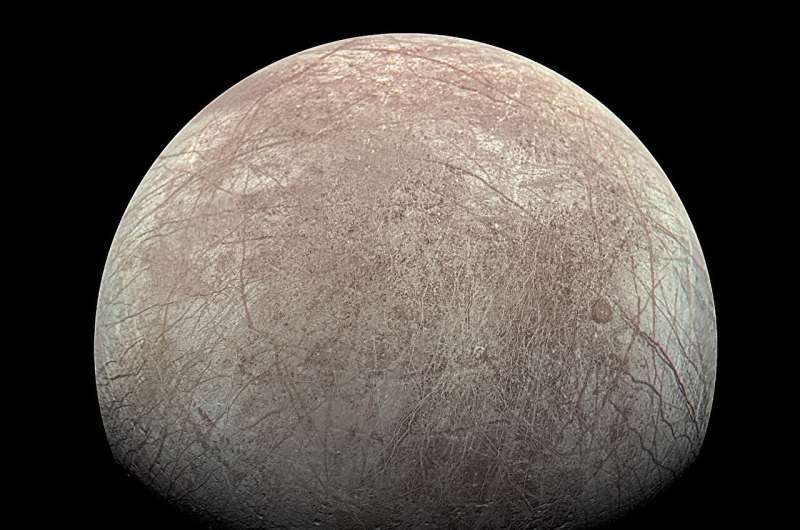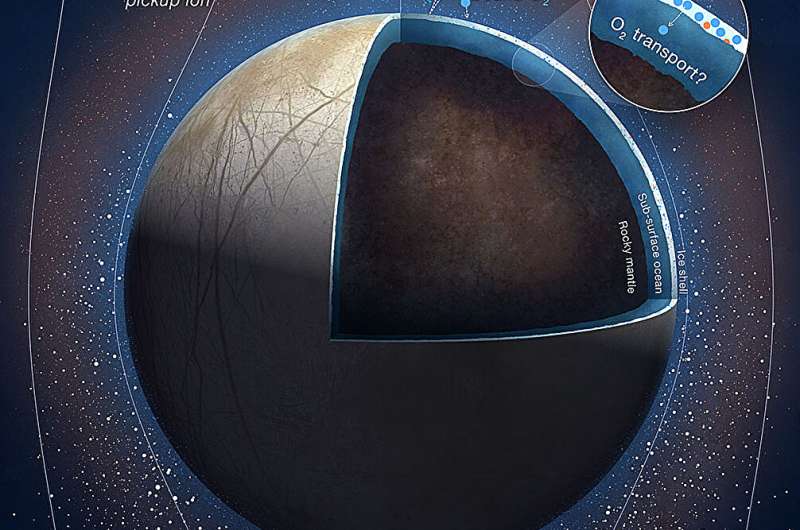This article has been reviewed according to Science X's editorial process and policies. Editors have highlighted the following attributes while ensuring the content's credibility:
fact-checked
peer-reviewed publication
reputable news agency
proofread
Jupiter's moon Europa may have less oxygen than expected, a finding that might put a damper on life

New research suggests there's less oxygen on the icy surface of Jupiter's moon Europa than thought—and that could affect what if any life might be lurking in the moon's underground ocean.
Even with little or no oxygen, microbes might still be bustling around in the ocean believed to exist miles (kilometers) beneath Europa's frozen crust. As for what else, "who knows," said NASA scientist Kevin Hand, who was not involved in the study published Monday in Nature Astronomy.
More work is needed to confirm these findings, which are contrary to earlier telescope observations of condensed oxygen in Europa's ice, indicating a higher oxygen concentration, said Hand.
The new study is based on data collected by NASA's Juno spacecraft during a particularly close flyby of Europa in 2022—a distance of just 219 miles (353 kilometers).
A U.S.-European team calculated that between 13 pounds and 39 pounds (6 kilograms and 18 kilograms) of oxygen are produced every second at Europa's surface.

Previous estimates had a much wider spread, with as much as 2,245 pounds (1,100 kilograms) of oxygen produced per second. So "unless Europa's oxygen production was significantly higher in the past," the new measurements provide "a narrower range to support habitability," the researchers wrote.
This oxygen is formed, along with hydrogen, as Jupiter's radiation blasts Europa's global shell of frozen water.
Lead author James Szalay of Princeton University said Juno's flyby was the first time a spacecraft "directly sniffed" Europa's surroundings. "We couldn't wait to peek behind the curtain of its complex environment," he said in an email.
While it's "a significantly narrower range than we previously thought, there's still a lot we can learn," Szalay said.
It's unknown how much oxygen escapes into the moon's atmosphere, how much remains in the ice and how much might find its way to the subterranean sea.
NASA plans to launch the Europa Clipper this fall. The spacecraft will make dozens of close flybys of Europa—nearly the size of our moon—while orbiting the giant gas planet.
More information: Jamey R. Szalay, Oxygen production from dissociation of Europa's water-ice surface, Nature Astronomy (2024). DOI: 10.1038/s41550-024-02206-x. www.nature.com/articles/s41550-024-02206-x
Journal information: Nature Astronomy
© 2024 The Associated Press. All rights reserved. This material may not be published, broadcast, rewritten or redistributed without permission.



















